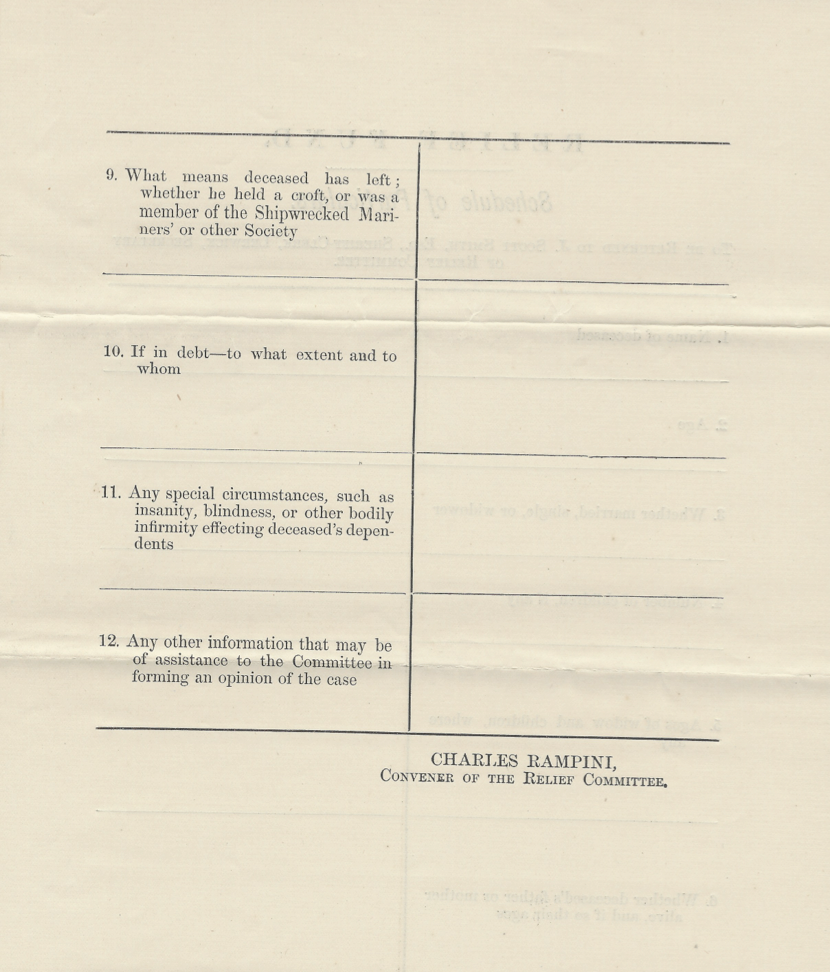The Quakers in
Shetland.
Perhaps a less well
known aspect of the aftermath of the 1881 disaster is the interest
and active involvement of the Quakers. The most complete, yet
tantalising incomplete account, is contained in the Shetland News of
the 25th September 1930, and in some subsequent editions.
A Mr William Whiting, a descendant of Mr John Whiting of Leeds ( a
prominent citizen, committed quaker and carpet manufacturer) visited
Shetland and had brought with him some of his farther's letters
written in the 1880s. The Society of Friends in many areas of England
committed funds to the relief, but the Yorkshire quakers appear to
have been particularly seized of the need to act. Two quakers from
Birmingham are mentioned – one of which was a Joel Cadbury.
Further research would be necessary, but Joel is a common name in THE
Cadbury family who came from Birmingham – and were quakers.
The letters tell of
the poverty and suffering of the people, and they seem to have
travelled widely to visit the needy. A couple of extracts -
We (travelled)
about 6 miles when we had to take a boat for about 3. It was a very
rough shore and the sea (was)
such as would have frightened many, but having 4 strong men to row we
got on well. In one place we had to cross through a narrow
channel(1/2 mile) (Bluemell
Sound?), the tide from both oceans met boiling and seething
as I never saw before, but we soon after came into smooth water
before Cullivoe, where we are now, at the house of Mr Sandison who is
postmaster, Clerk to the School Board, Parish Board, and general
factotum.
I am unsure as to
whether Duncan Sandison, who kindly showed us the Unst Boat Haven
(see previous post), would appreciate being descended from a “general
factotum”. I suspect it was a more flattering phrase when used in
the 1880s.
…..having been
engaged from 10until 6 making calls on the 19 families in Gloup. They
were widely scattered and involved on the part of John Cass and
myself a walk with a guide over rough and broken ground of about 5
miles –7 visits –Annie C. (the
wife of John Cass) and John Wilson had 11 of those near
our quarters. The calamity was more felt in this neighbourhood
(Colvaster, North Yell, near
Gloup Voe) Within one mile from one of the families we
visited, 19 men had been lost and mostly young men who were the hope
of their parents.
Undoubtedly
dedicated and sincere in their desire to help. There are follow up
stories along the same vein, and accounts of how the quakers funded
new decked boats for the men. At the time of the 1881 visit, the
quakers made contact with the Relief Committee to which a total of
£12,500 was donated by subscription from the general public. The
Committee seem to have been quite prescriptive in their allocation f
the funds. Indeed, of the £12,500 raised it appears that only £7000
was allocated to the annuities and immediate relief. The quakers
appear to have been less constrained. On one visit they gave £6 on
the spot to a widow who had lost a husband and eldest son, so that
the 3 remaining sons could purchase a replacement boat.
One other extract
points to a frustration that the quakers felt with the stance of the
Relief Committee -
Our interview
with the Committee was not as satisfactory as we should have liked.
They were not able to give us anything definite as to the scale or
mode of relief to be given …...We were with them about an hour and
a half. It ended with our not entering any alliance with them,
reserving it for consideration with our friends at home.
It is difficult
many years later to understand the various positions taken, but one
bone of contention is clear. Fishermen, in the main, rented their
boats from landowners, merchants and lairds. The rental was usually
paid at the end of the season against receipts for catches. The boat
owners pressed for payment from the widows left behind. They were
obviously not in a position to raise such funds (estimated at £10
per year) and so were left with an unpayable debt. The Relief
Committee refused to allow such debts to be paid from the fund, and
this led to evictions, despite the widows allowance of 2/6d (12 ½
pence in new money) a week. Children up to 14 and other dependants
usually received 1/6d per week. Not ungenerous, but not enough to
repay the inherited debts.
In conversations
with today's locals, some of older generation remember their
forebears praising the work of the quakers. Most of the music I am
attempting to create for the production is of a local flavour. But I
was so inspired by reading of the work of the quakers, and the
Yorkshire connection (despite my Lancastrian roots) that I have
composed a brass band tune. It is in fairly embryonic form, but it
might just, with some improvements and re-recording, play as a
backdrop to the story of the quakers and the Gloup 1881 disaster.











